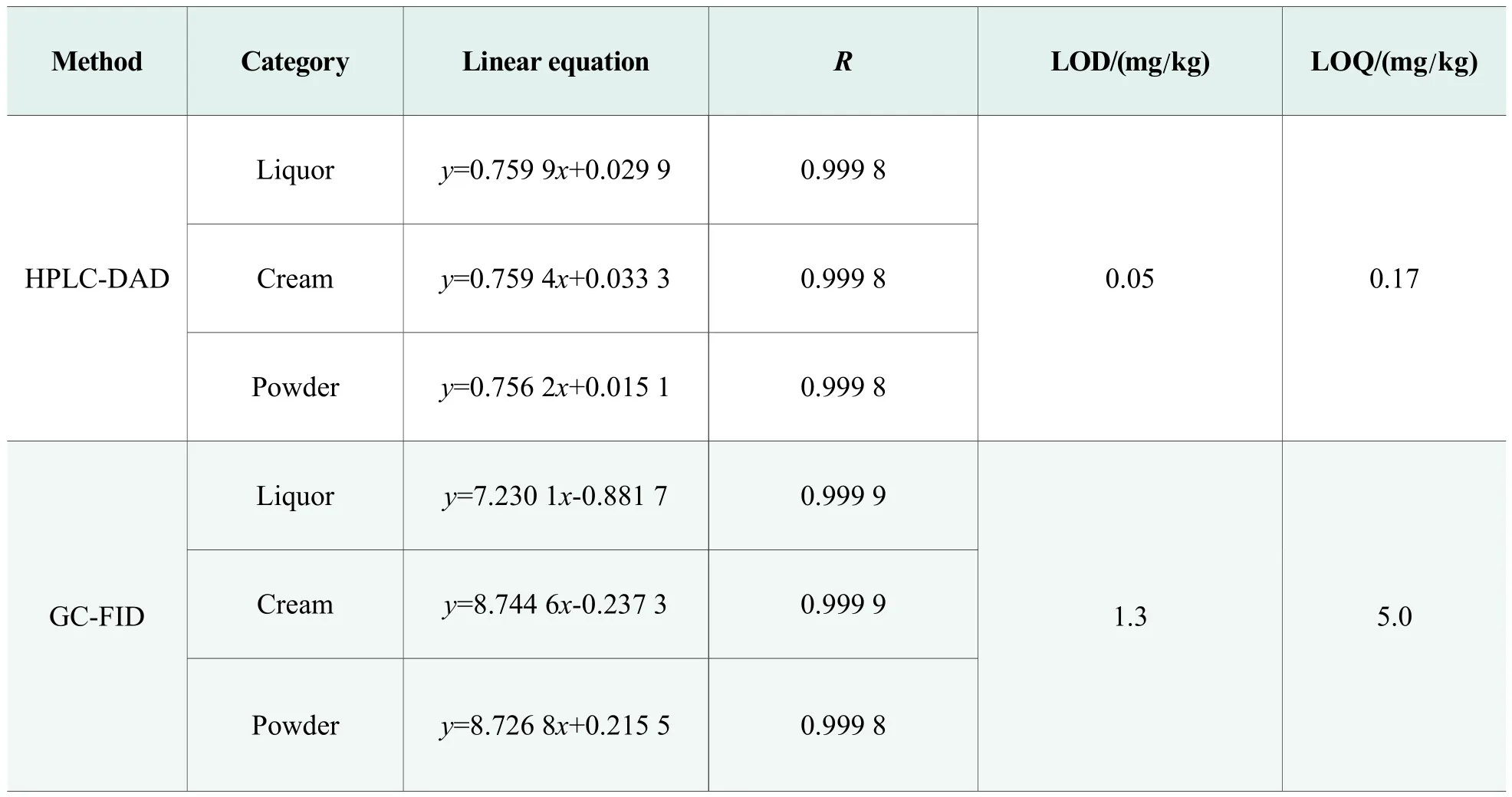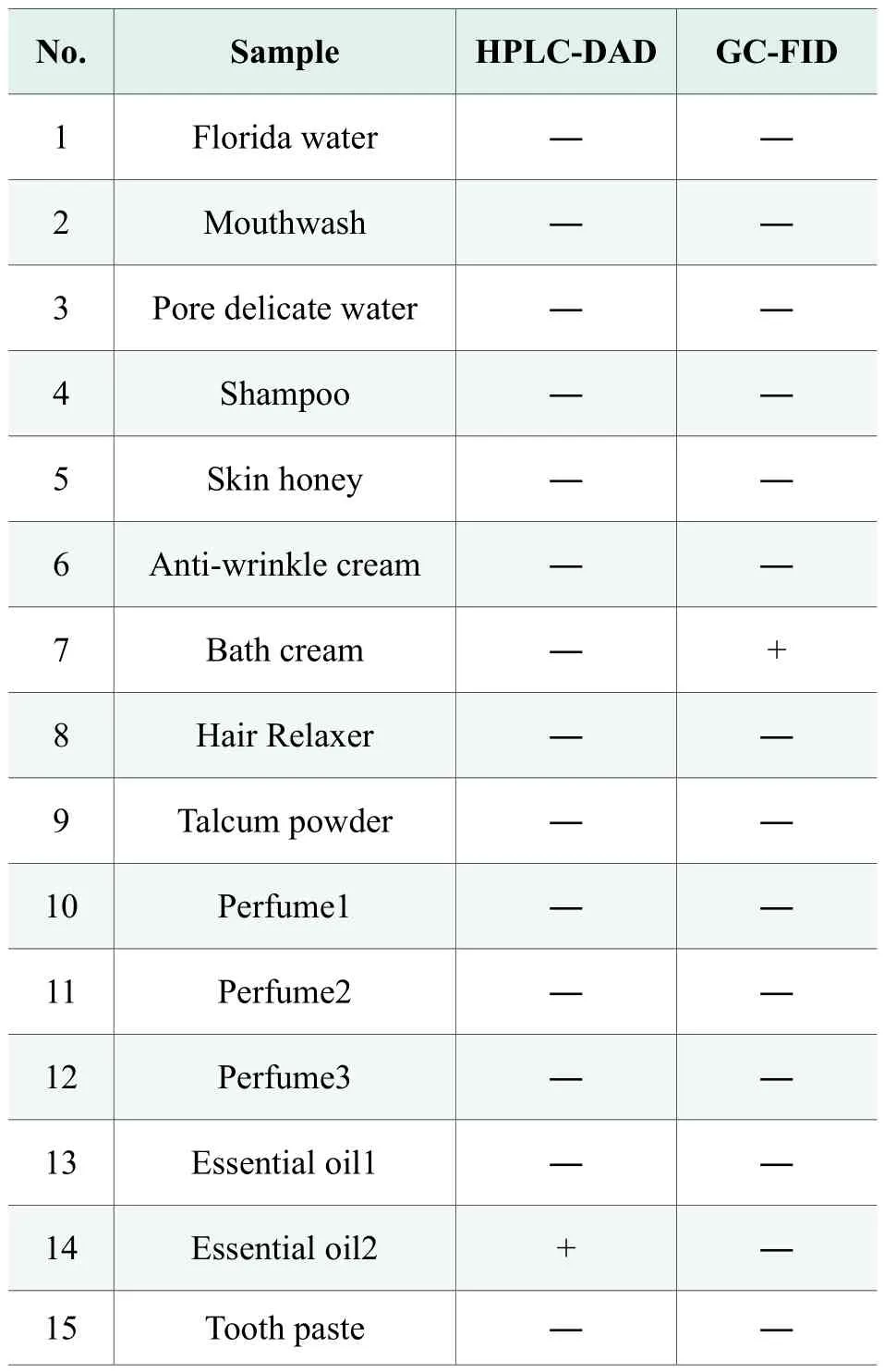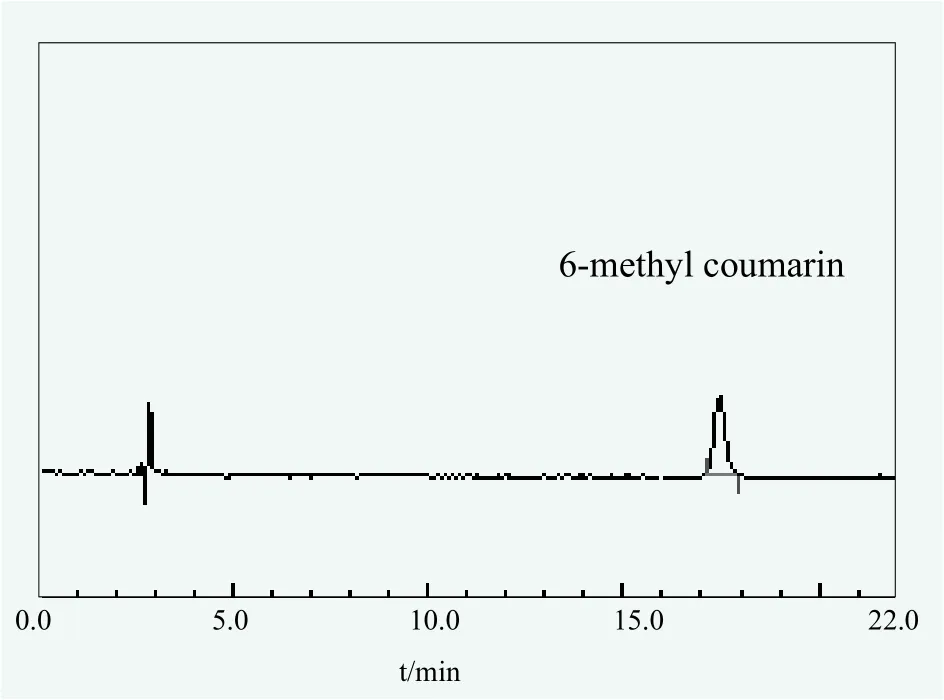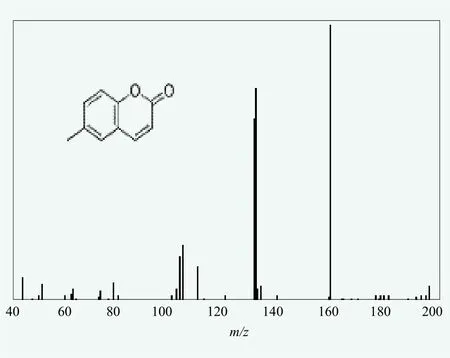Comparison of HPLC-DAD and GC-FiD Methods for Determination of 6-Methyl Coumarin in Cosmetics
Liu Hong, Zhang Jingya, Hu Bei, Wei Liuzhen
Hubei Institute for Drug Control, China
Abstract The methods of determination of 6-methyl coumarin in cosmetics by HPLC-DAD and GC-FID were compared. The positive samples were confirmed by GC-MS. Methanol was used to extract 6-methyl coumarin from cosmetics. The chromatographic conditions of the two methods were optimized and the samples were determined. The recovery, precision, correlation coefficient, detection limit and quantitative limit of the two methods were compared. The results showed that the linear relationship between the two methods was good. The percentage recovery of standard addition by HPLC-DAD was 92.20%~102.80%, by RSD was 0.77%~2.00%; the detection limit was 0.05 mg/kg, the quantitative limit was 0.17 mg/kg. The percentage recovery of standard addition by GC-FID was 97.30%~103.28%, by RSD was 0.47%~4.87%; the detection limit was 1.3 mg/kg, the quantitative limit was 5.0 mg/kg. The detection limit by HPLC-DAD was lower and more sensitive than that by GC-FID , which also shows that HPLC-DAD has more advantages for the detection of low content samples.
Key words cosmetic additives; HPLC-DAD method; GC-FID method; 6-methyl coumarin
6-methyl coumarin is a derivative of coumarin and also an important spice, with strong coconut aroma.It is commonly used as fixing agent and deodorant,and is mainly used in the preparation of coconut,vanilla, caramel and other flavors.[1]Toxicological experiments have shown that coumarin is toxic to mouse embryos, that it can cause the disappearance of pain sensation, that it changes neutral cholinesterase,and that it is a suspected tumor-causing substance in rats.[2]Moreover, it is also a photosensitive dermatitis sensitizer. When cosmetics containing 6-methyl coumarin are applied on the skin surface, skin inflammation will be caused when skin is exposed to light,[3]and it is harmful to human liver. 6-methyl coumarin is a restricted substance in GB7916-1987 Hygienic Standards for Cosmetics, which stipulates that the maximum allowable concentration of 6-methyl coumarin in oral products is 0.003%. In addition, the Technical Specification for Cosmetic Safety (2015 Edition) stipulates that 6-methyl coumarin is a prohibited substance.
Currently, the commonly used quantitative detecting methods for 6-methyl coumarin include HPLC[4]and gas chromatography (GC).[5]Gas chromatographymass spectrometry (GC-MS) is mainly used for qualitative analysis and confirmation of positive samples.[6]HPLC-DAD method and GC-FID method have their own advantages in the determination of 6-methyl coumarin in cosmetics. For further study,the two methods were optimized and compared,further the positive samples were confirmed by GC-MS.
Experiment
Reagents and instruments
Acetonitrile, methanol, chromatographic purity,Merck Company, USA; anhydrous sodium sulfate,sodium dihydrogen phosphate, analytical purity,China Pharmaceutical Group Chemical Reagent Co.,Ltd; 6-methyl coumarin standard substance (batch number 13864, w=100%), Accustandard Company,USA.
Agilent 1260 High Performance Liquid Chromatography equipped with Diode Array Detector (DAD),Agilent 7890A Gas Chromatography (FID), Agilent Corporation, USA; ST-16 Centrifuge, Thermo Fisher Company, USA; Milli Q Deionized Water Generator,Millipore Company, USA; HMV-50A Multi-tube Mixer, Tianjin Heng'ao Technology Development Co., Ltd; LC-250 Ultrasound; Wave Cleaner,Shandong Jining Luzhou Ultrasound Equipment Co., Ltd.
HPLC conditions
Chromatographic column: COSMOSIL 5C18-AR-Ⅱ(250 mm × 4.6 mm, 5 μm); Mobile phase :methanol-0.02 mol/L sodium dihydrogen phosphate buffer solution (pH=3.5) (volume ratio 45:55); Flow rate: 1 mL/min; Detection wavelength: 275 nm;Column temperature: 35 ℃; Injection volume 10 μL.
GC conditions
The chromatographic column was Agilent HP-5 capillary column (30 m × 0.32 mm, 0.25 μm ).The temperature program of the column: the initial temperature of 100 ℃, keep 3 min, at a rate of about 8 ℃/min to 200 ℃, keep 3 min. Injection port temperature 250 ℃; The detector temperature 280 ℃;Carrier gas: nitrogen 1.0 mL/min; Gas: hydrogen 30 mL/min; Auxiliary gas: air 400 mL/min; Tail blowing: nitrogen 30 mL/min; Injection mode:splitless injection; Splitless injection volume 1.0 μL.
GC-MS confirmation conditions
The chromatographic conditions of GC-MS referred to the method of gas chromatography.According to the selection principle of characteristic ions in mass spectrometry, 160, 132 and 131 with high abundance, high mass numbers and less interference from samples were selected as characteristic ions.According to the molecular weight and characteristic ion peak of 6-methyl coumarin, 40~200 were selected as the monitoring ion range (m/z).
Preparation of standard reserve solutions and series standard working solutions
100 mg of 6-methyl coumarin was accurately weighted in a 100 mL volumetric flask. Add methanol to dissolve, then the standard stock solution with mass concentration of 1 g/L was obtained. Precisely transfer 5.0 mL of this standard stock solution to a 50 mL volumetric flask, and then dilute with methanol to volume, finally the standard solution with mass concentration of 100 mg/L was obtained. A series of standard working solutions with mass concentration of 0.1, 0.5, 1.0, 3.0, 5.0 and 10.0 mg/L were prepared by precisely taking appropriate amount of the above solutions, and methanol was added to dissolve and dilute the solution to the scale.
Sample pretreatment
1.0 g (accurate to 0.01 g) sample was weighed in a 10 mL volumetric bottle and 5 mL methanol was added. The sample was fully mixed with the extracting solvent by Vortex oscillation, extracted using ultrasound for 20 minutes, and cooled at room temperature. The sample was then diluted with methanol to volume, mixed and transferred to 10 mL scale centrifugal tube, centrifuged at 5,000 r/min for 5 mins. The supernatant was dehydrated by 3 g anhydrous sodium sulfate and filtered by 0.45 μm filter membrane. The filtrate was used as sample solution.
Results and discussion
Optimization of extraction methods
Optimization of extraction conditions
According to the physical properties of 6-methyl coumarin, which is soluble in ethanol, oil, very little in hot water and insoluble in petroleum ether,[7]three soluble organic solvents were selected: methanol,ethanol and acetone. After extraction by acetone,there were more impurities and interference. The extraction rate of ethanol was slightly lower than that of methanol, so methanol was chosen as the extraction solvent.
Optimization of ultrasonic time
Ultrasound time was compared between 10, 20,30 and 40 minutes. The extraction in 10 min was incomplete, and there was no significant difference in the extraction rate between 20, 30 and 40 minutes.So, 20 min was selected as the optimum extraction time.
Optimization of HPLC conditions
Five kinds of mobile phases were selected:
1) methanol-0.85% phosphoric acid solution;
2) methanol-0.02 mol/L ammonium acetate;
3) methanol-0.02 mol/L sodium dihydrogen phosphate;
4) acetonitrile-0.02 mol/L ammonium acetate;
5) acetonitrile-0.02 mol/L sodium dihydrogen phos-phate. The results showed that methanol 0.02 mol/L sodium dihydrogen phosphate (pH=3.5) could effectively separate 6-methyl coumarin from other components in the chromatogram.
Selectivity of GC conditions
Based on reference[7]and the structural features of 6-methyl coumarin, which has a lactone ring with weak polarity, HP-5 column was selected,and ideal chromatographic response value were obtained with splitless injection. More than 10 kinds of column temperature programs were compared.The column temperature program was selected which kept at 100 ℃ for 3 minutes, then increased to 200 ℃at the rate of 8 ℃/min and kept for 3 min as the peak shape of 6-methyl coumarin was presented well,and at the same time, the residual components in the column can be removed to a greater extent.
Comparison of two determination methods
Linearity, detection limit, quantity limit of the two methods
Under the conditions of two methods, the mass concentration of 6-methyl coumarin was determined in the range of 0.5-10 mg/L, and the peak area(y) was determined by the mass concentration(x, mg/L). The detection limits and quantitative limits of the two methods were calculated by 3 times SNR and 10 times SNR respectively. Linear equation, correlation coefficient, detection limit and quantitative limit are shown in Table 1.
As can be seen from Table 1, the linear relationship of the two methods is good, and the detection limit and quantitative limit of HPLC-DAD method are lower than that of GC-FID method.
investigation of the stability of the two methods
Under the condition of the two methods, the stability of standard working solutions with mass concentration of 1 and 5 mg/L at room temperature for 0, 2, 4, 8,12 and 24 hours and that of 0, 2, 4, 8, 12, 24, 48 and 72 hours in refrigerator at 4 ℃ were investigated.The RSD of intra-day and inter-day precision of the two concentrations by HPLC-DAD were 1.18%, 1.15%, 0.78% and 1.38%, respectively.The RSD of intra-day and inter-day precision of the two concentrations by GC-FID were 2.00%,2.24% and 0.70%, 0.74% respectively. The RSDs of GC-FID The results showed that the standard working solution of 6-methyl coumarin was stable at room temperature for 24 hours and refrigeration at 4 ℃ for 72 hours under the condition of the two methods.
Recovery and precision of the two methods
Under the conditions of the two methods, two different levels (10 and 50 μg) were added to different types of cosmetics, and three recovery tests were carried out at each level. The results are shown in Table 2.

Table 1. Regressions equation, correlation coefficients, detection limits and quantitative limits

Table 2. RSDs and recoveries of different cosmestics(n=3)
Table 2 shows that the recoveries of HPLC-DAD method are 92.20%~102.80% and corresponding RSD is 0.77%~2.00%. The recoveries of GC-FID method are 97.30%~103.28% and corresponding RSD is 0.47%~4.87%. Both methods meet the requirements of the Technical Specification for the Verification of Detection Methods of Prohibited and Restricted Substances in Cosmetics and Their Raw Materials (the prescribed recovery rate is 85%~115%), which are suitable for the analysis of 6-methyl coumarin in cosmetics.
Sample determination
Under the conditions of two methods, 11 different types of cosmetics sold in the market were determined. The results are shown in Table 3.

Table 3. Results of determination of samples
The results showed that only two of the 11 batches of samples were positive. One batch of bath lotion samples detected by GC-FID were positive, and two batches of essential oil samples detected by HPLCDAD were positive. The positive samples were further confirmed by GC-MS. In the corresponding retention time, there was no characteristic ion peaks in the chromatogram of the shower gel, which indicate that the positive results by GC-FID method were false positive, and there was no 6-methyl coumarin in the shower gel. However, the two samples of essential oil were confirmed by GC-MS, there are the same fragment ions as 6-methyl coumarin. The main reason why 6-methyl coumarin is not detected by GC-FID is that the content of 6-methyl coumarin in the two samples is 0.7 mg/kg, which is lower than the detection limit and quantitative limit of GC-FID.The sensitivity of HPLC-DAD method is higher than that of GC-FID, so it can accurately detect 6-methyl coumarin, and the result was consistent with the confirmation of GC-MS.
The HPLC and GC chromatograms of 6-methyl coumarin are shown in Figure 1 and 2, and the HPLC chromatogram and MS spectrum of essential oil samples are shown in Figure 3 and 4.

Figure 1. High performance liquid chromatogram for standard solution of 6-methyl coumarin

Figure 2. Gas chromatogram for standard solution of 6-methyl coumarin

Figure 3. High performance liquid chromatogram for sample of essential oil 2

Figure 4. Mass chromatogram for sample of essential oil 2
Conclusion
The determination of 6-methyl coumarin in cosmetics by HPLC-DAD and GC-FID were compared.The two methods have their own characteristics and can be selected according to the equipment and technical conditions of each laboratory. At the same time, different detection methods can corroborate each other's test results. Because of the higher sensitivity, it is more advantageous for the determination of samples with very low content.
 China Detergent & Cosmetics2019年1期
China Detergent & Cosmetics2019年1期
- China Detergent & Cosmetics的其它文章
- The Methodology of Cosmetics Efficacy Evaluation to Provide Scientific Support for Soothing Skin Efficacy Claims
- Determination of Bemegride and its Salts in Cosmetics by HPLC and Their Verification by HPLC-MS/MS
- Research on the Preparation of an Anti-Acne Cream and its Thermal Stability
- Fluorinated Surfactants and Fluorinated Polymer Materials (i):General Review
- Research Progress on the Relationship between Skin Microbial Flora and Skin Health
- Determination of 24 Allergens in Perfume with High Performance Liquid Chromatography Tandem Mass Spectrometry
